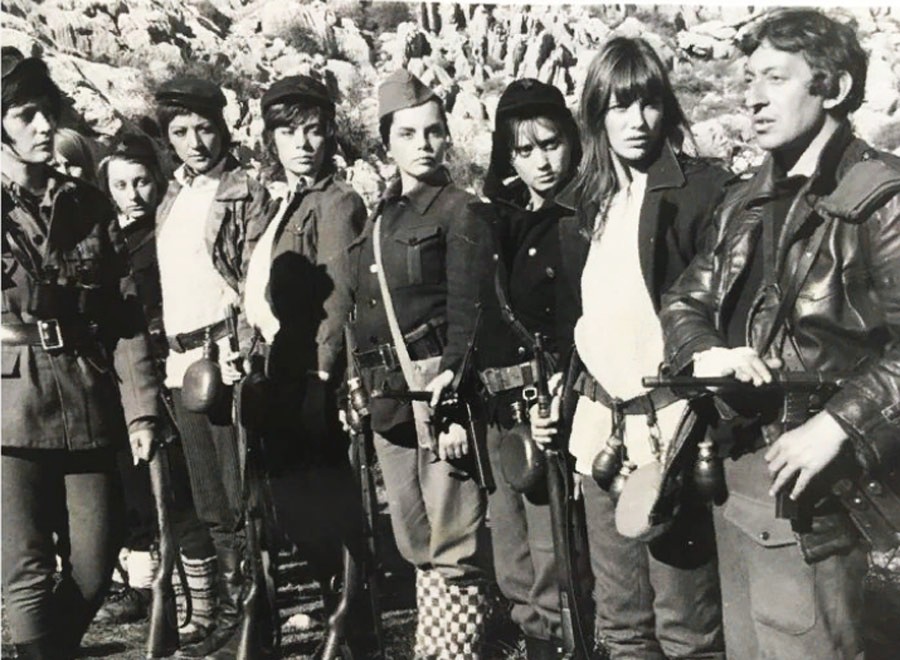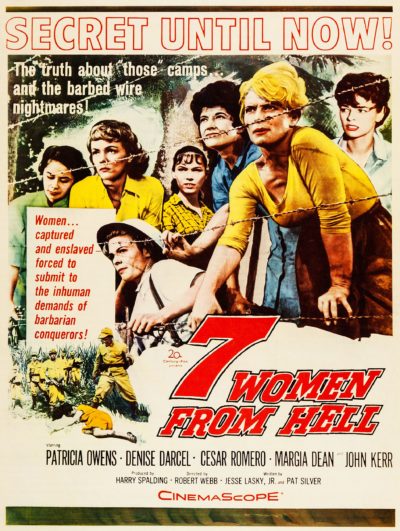★★★½
“Light pink(y)”
 Made by Toei, this is very much a straightforward “pinky violence” film in concept, telling the story of the Wildcats and, in particular, their leader Maki Hyuga. What separates this – in ways both good and bad – from the pack is that Maki is played by Sue Shiomi, best known for her roles in the Sister Streetfighter series of films. That means the action in this is considerably improved on the typical pinky violence movie, with Shiomi capable of holding her own, even when fighting many opponents. In particular, her skills with a pair of nunchaku is a sight to behold. The scenario here provides plenty of opportunities for her to show all her abilities off.
Made by Toei, this is very much a straightforward “pinky violence” film in concept, telling the story of the Wildcats and, in particular, their leader Maki Hyuga. What separates this – in ways both good and bad – from the pack is that Maki is played by Sue Shiomi, best known for her roles in the Sister Streetfighter series of films. That means the action in this is considerably improved on the typical pinky violence movie, with Shiomi capable of holding her own, even when fighting many opponents. In particular, her skills with a pair of nunchaku is a sight to behold. The scenario here provides plenty of opportunities for her to show all her abilities off.
However, the downside is that Shiomi is simply too “good” to play a bad girl. When you put her beside the titans of the genre, like Meiko Kaji or Reiko Ike, Shiomi just does not have the necessary edge to succeed as the leader of an all-female gang of delinquents. Any group led by Shiomi would, I feel, be more likely to sell you cookies or help old ladies across the road, than beat you up and take your lunch money. It’s notable that, while this is certainly not short on the nudity required in the field, Shiomi remains firmly attached to her clothes. Others take care of this onerous duty, with the heroine instead providing the second half of the sex ‘n’ violence recipe.
The story sees Maki running foul of Yakuza chief Ryunosuke Daimon (Nawa) after rescuing a girl from his white slavery operation, and also annoying rich bitch Takako Ebihara (Ohara). Their revenge ends in Maki being framed and sent to prison, while the rest of her gang get hooked on smack by Daimon, and turned into compliant slaves. However, she gets help from an unexpected quarter, in the form of Daimon’s top bodyguard Tetsuya Eto (Nanjô), an honourable ex-boxer who grows increasingly unhappy with his boss’s sleazy business practices. Takako is also unimpressed when she discovers she’s going to be married off to Daimon, whether she wants to be or not. That comes after he has blown up Takako’s father with a car-bomb.
Things unfold as you’d expect. Maki wins the respect of her cell-mates, breaks out and, with Tetsuya are her back, storms the headquarters of Daimon’s yakuza clan, just as he is in the process of getting married to Takako. She’s not there to bring the gang boss a toaster or some nice crockery. If almost entirely predictable, the presence of Shiomi, and resulting upgrade in the quality of the fight sequences does make it feel relatively fresh in style – just not in content. The main factor which stops it reaching the top tier for the genre is the sense Shiomi is almost cos-playing as a bad girl, something you never doubted with the Queens of Pinky Violence. There’s good reason she only dabbled in this field.
Dir: Makoto Naitô
Star:Etsuko Shihomi, Misa Ohara, Tatsuya Nanjô, Hiroshi Nawa





 This feels a little like a Dutch cross between the stories of Joan of Arc and William Wallace. It’s a couple of centuries later than either, taking place (as the non-Dutch title states!) in the 16th century. The Spanish armies of the Catholic King Philip II were sweeping across Europe, reaching as far North as the Netherlands. Some cities capitulated; others resisted. Among the latter was Haarlem (to use the Dutch spelling), where legend states a woman called Kenau Simonsdochter Hasselaer led an army of 300 women in defense of the city. The more prosaic reality is that she may have helped in fortifying the defense, though the amount of reliable historical data about her is scant in the extreme.
This feels a little like a Dutch cross between the stories of Joan of Arc and William Wallace. It’s a couple of centuries later than either, taking place (as the non-Dutch title states!) in the 16th century. The Spanish armies of the Catholic King Philip II were sweeping across Europe, reaching as far North as the Netherlands. Some cities capitulated; others resisted. Among the latter was Haarlem (to use the Dutch spelling), where legend states a woman called Kenau Simonsdochter Hasselaer led an army of 300 women in defense of the city. The more prosaic reality is that she may have helped in fortifying the defense, though the amount of reliable historical data about her is scant in the extreme. ★★
★★ While this is not an “official” remake of Gloria, it’s so damn close that I have no problem considering it as one. Writer/director Gaston seems to have… um, a bit of a track record in this area, shall we say. She previously appeared here by directing
While this is not an “official” remake of Gloria, it’s so damn close that I have no problem considering it as one. Writer/director Gaston seems to have… um, a bit of a track record in this area, shall we say. She previously appeared here by directing  About the only review online I found for this, said it “may be the worst movie released in 1961.” I can only presume the writer of that statement has never seen The Beast of Yucca Flats. Even if I admit its weaknesses, Seven is nowhere near the same league of badness. Indeed, it starts off well, depicting the sudden invasion of Papua New Guinea by Japanese forces in 1942, with “enemy” civilians being herded into interment camps. The ones on the women’s side are a multi-national bunch, including Australian Grace Ingram (Owens), several Americans including Janet Cook (Craig), a German widow Ann Van Laer (Sylvia Daneel), Frenchwoman Claire Oudry (Darcel), and mixed-race nurse Mai-Lu Ferguson (Pilar Seurat).
About the only review online I found for this, said it “may be the worst movie released in 1961.” I can only presume the writer of that statement has never seen The Beast of Yucca Flats. Even if I admit its weaknesses, Seven is nowhere near the same league of badness. Indeed, it starts off well, depicting the sudden invasion of Papua New Guinea by Japanese forces in 1942, with “enemy” civilians being herded into interment camps. The ones on the women’s side are a multi-national bunch, including Australian Grace Ingram (Owens), several Americans including Janet Cook (Craig), a German widow Ann Van Laer (Sylvia Daneel), Frenchwoman Claire Oudry (Darcel), and mixed-race nurse Mai-Lu Ferguson (Pilar Seurat).  I went into this preparing to hate it. There had been red flags all over the place, such as star and producer Chastain coming out with comments about her movie like, “It’s very important for society. We’ve moved against the status quo, and we’re creating our own narrative for it. The film is, in some sense, a political act.” Uh-oh. No film is
I went into this preparing to hate it. There had been red flags all over the place, such as star and producer Chastain coming out with comments about her movie like, “It’s very important for society. We’ve moved against the status quo, and we’re creating our own narrative for it. The film is, in some sense, a political act.” Uh-oh. No film is  Oh, dear. There’s part of me which thinks this is what you get when you try and make actors out of pool players. For the star here, Barretta, is one of the top women cue artists in the world. She’s joined here by cameos from a couple of bigger pool stars i.e. people even I’ve heard of, in Jeanette ‘The Black Widow’ Lee and Allison Fisher, and you can’t really expect much out of any professional sportswomen, in terms of acting ability. However, she isn’t that bad, though this may just be relative to some of her fellow cast members. And, to be fair to the actors here, you could be an Oscar-winner, and still not be able to do anything with the wretched script, which is little more than a parade of cliches, when not being a shameless advert for the American Poolplayers Association and its leagues.
Oh, dear. There’s part of me which thinks this is what you get when you try and make actors out of pool players. For the star here, Barretta, is one of the top women cue artists in the world. She’s joined here by cameos from a couple of bigger pool stars i.e. people even I’ve heard of, in Jeanette ‘The Black Widow’ Lee and Allison Fisher, and you can’t really expect much out of any professional sportswomen, in terms of acting ability. However, she isn’t that bad, though this may just be relative to some of her fellow cast members. And, to be fair to the actors here, you could be an Oscar-winner, and still not be able to do anything with the wretched script, which is little more than a parade of cliches, when not being a shameless advert for the American Poolplayers Association and its leagues.

 Is it possible for an action heroine film to still be chauvinist? While that criticism was frequently levelled at
Is it possible for an action heroine film to still be chauvinist? While that criticism was frequently levelled at